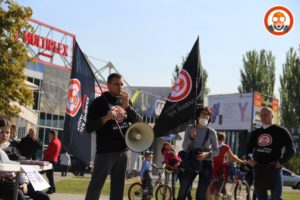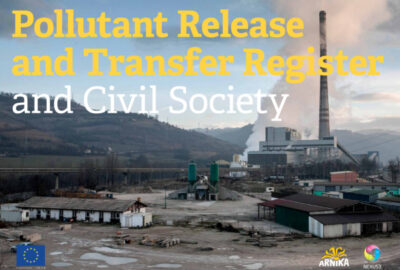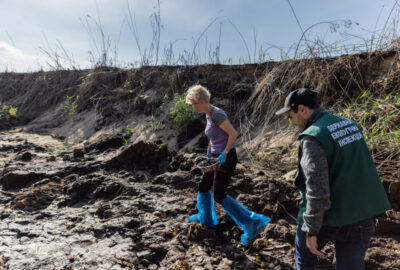“I beg all of you: here in Kryvyi Rih we have polluted air and toxic water in which we cannot bathe. Stop poisoning Kryvyi Rih! Support ecology and don’t pollute the environment. Otherwise we can hardly live here,” appeals Alina Shafranova, who is only nine years old and the daughter of local activist Elena, in her video, which she streamed live on social media. It’s a sunny autumn day, Sunday September 30th 2018. Alina spends this day by protesting with other citizens and their goal is not only to sound the alert about critical air pollution, but also to support demonstrations in other industrial cities of Ukraine: Mariupol and Zaporizhzhya.
Steel giant Kryvyi Rih
Kryvyi Rih, the longest city in Europe, with its 120 kilometres stretching along the iron ore deposits, looks like a scar in satellite pictures because of the many open-cast mines. The former headquarters of the Ukrainian Cossacks don’t offer sunshine and a bright future to children like Alina. Its industrial exterior was used by Sergei Loznitsa when shooting his film Donbas (2018). The lives of the majority of the population living in the city called the “steel heart of Ukraine” have been deeply connected with metallurgy and mining for two hundred years. The main source of income for the whole region is the ArcelorMittal Kryvyi Rih steelworks, which was built in 1934. It is the biggest steelworks in Ukraine, with a complete metallurgical cycle, exporting to more than 160 countries. Thanks to that, Ukraine is the world’s sixth-biggest steel exporter.
“It’s alarming how the number of oncological diseases and cases of tuberculosis is rising in Kryvyi Rih,” says Elena Shafarnova, a local lawyer and mother of little Alina, who started to take an interest in air pollution when Alina was diagnosed with asthma. “I realised that we need to do something. So we started by founding the coalition.” This happened in 2017 and since then the coalition Stop Poisoning Kryvyi Rih (Досить труїти Кривий Ріг / Dosit truiti Kryvyi Rih) has united more than ten local initiatives, which focus on the environment, social topics, and the engagement of the public in decision-making procedures. Elena works in the coalition in the same way as her colleagues; she volunteers in her free time. In November 2016 she co-organised the first demonstration demanding the reduction of emissions. Around two hundred people blocked the bridge and driveway to the steelworks for half of the day. The result of this protest was a signed memorandum about establishing a working group of twenty members of the coalition and ten employees of ArcelorMittal. The participation in this group allows the locals to supervise whether Arcelor implements ecological measures, and also to get access to the factory. The declared goals are a reduction of emissions through modernisation, the replacement of outdated technology by 2020, surveillance of the modernisation of the steelworks, and a guarantee of independent air pollution surveillance, because activists don’t consider the official data of the Ukrainian authorities to be reliable.
Mariupol or Akhmetovsk?
On the same day as Alina and Elena, people from Mariupol, 400 kilometres away from Kryvyi Rih, are also protesting. Besides that there’s the City Day. With the hashtag #яхочудихати (I want to breathe), social media are flooded with pictures and videos of locals with masks or even gas masks on their faces. This is not their first time in the streets. In the last six years, Mariupol has been a regular witness of massive ecological protests. Almost 98% of all the emissions from this city come from the two steelworks from the Metinvest group, owned by the Ukrainian oligarch Rinat Akhmetov; 10% of all Ukrainian industrial production comes from Mariupol. During the 20th century, the city focused almost exclusively on iron and steel processing. Since the nineties this city, with 462,000 inhabitants, has been dependent on the one oligarch.
In January 2012, a small, informal group, “Let us breathe! (Дайте кислорода!)”, led by the activist Maksim Borodin, organised the first ecological protest with 800 inhabitants of Mariupol. During the year, the number of members of the group rose and in December 2012 another protest was held; it was one of the biggest ecological demonstrations in the history of Ukraine. 10,000 people came to the city hall with respirators on, and 13,000 people signed a petition demanding an immediate improvement in air quality. The petition was afterwards submitted to the Ukrainian government and the president. After negotiations with Metinvest, the company promised to invest in modernisation, moved the production from the obsolete Azovstal Iron and Steel Works to the nearby Ilyich Iron and Steel Works, and launched the reconstruction of the Azovstal sinter plant. The three old coke ovens were shut down and a couple of filters at Azovstal were repaired. The city council and the company promised people that they would do their best and reduce emissions by 40% by 2020.
“Before we started to push Metinvest to adapt the ecological norms, we used to breathe orange air daily. Nowadays, the air in Mariupol is considerably better. The modernisation has not been completed yet, but the owner is now aware of public surveillance,” says Maksim Borodin, who has gradually built a strong position as a citizen activist and has now become a respected authority in Ukraine. A law graduate and the owner of an IT company, he had the same motivation as Elena from Kryvyi Rih to become active in public affairs; it was concern about the health of his six-year-old son. Thanks to his tireless activism in ecology he has become the representative of Mariupol and nowadays he has made it to the finals of the popular Ukrainian reality show New Leaders. If he won, he would use the first prize of one million hryvnias to buy an alternative system for monitoring air pollution in Mariupol. The strategic port of Mariupol is only 20 kilometres away from the front line and in 2014 it was under the short-term control of pro-Russian separatists. Many people have moved away from the city. It was not only due to the ongoing war, but also due to the impossibility of developing small businesses when the gigantic industry focuses only on one direction and drives any other type of business away. “I believe in the huge potential of Mariupol as a seaside tourist resort and that one day we will make this idea come true. When the war is over and part of the steelworks will be closed for good and the other part of the plant will be modernised properly,” added Borodin.Zaporozhye,
Zaporizhzhya – Stalin’s city
In the last week of September, a demonstration for clean air was also organised in Zaporizhzhya as a sign of solidarity with Kryvyi Rih and Mariupol. Zaporizhzhya, with a population of seven hundred thousand and situated on the banks of the River Dnieper, has been one of the biggest industrial centres of Ukraine since Soviet times. The feature of this city is the huge concentration of factories in the city centre, the majority of them dating from the interwar period. There are 280 factories in total: mechanical engineering and the chemical and metallurgical industries. The main polluters are Ukrainian Grafit, Zavod Ferrosplavov from Zaporizhzhya, Zaporizhkoks, the heating plant, and the Zaporizhstal steelworks. One topic has resonated most in recent months: the locals are demanding that the municipality purchase a mobile laboratory for measuring the pollution. Similarly to the other industrial cities of Ukraine, the locals don’t trust the official data. In September 2015 the first large demonstration of locals from Zaporizhzhya took place. They called for better air quality and in 2017 the Ecological Coalition of the City of Zaporizhzhya was founded. Its aim is to implement a system of independent monitoring and to run an ecological school for the locals – through regular educational meetings related to ecological topics. “We observe a huge increase in public interest in ecology and we do our best to accommodate the needs of locals and educate them. We connect them with experts and organise debates and lectures,” states Iryna Pirogova, the director of the local organisation the All-Ukrainian Environmental League and one of the founders of the Ecological Coalition of the City of Zaporizhzhya.
The coordinated protests of almost seven thousand people from industrial cities of Ukraine in the last week of September confirm such a statement. For the first time in the twenty-seven-year history of independent Ukraine, the cities, previously isolated with their own problems, have started to collaborate. Activists are on the same page: “We understand that as individuals on our own we can do nothing. Primarily, we need to change the legislation and make the government implement the Association Agreement and European directives. We can only do this if we team up with other cities,” says Iryna Pirogova. “The most important thing is to change the Ukrainian legislation and adjust it as soon as possible to European standards, to which Ukraine made a commitment by signing the Association Agreement. It is necessary to arrive at a point at which it will be more convenient for the polluters to modernise the obsolete plants than bribe the authorities with a suitcase full of money,” added Maksim Borodin.
This year the Stop Poisoning Ukraine! coalition is actively supported by Arnika: in Zaporizhzhya, Kryvyi Rih, and Mariupol we took samples of river sediments and sand samples from playgrounds. We will investigate the amounts of heavy metals they contain. In November Maksim Borodin, Anna Ambrosova (co-founder of Stop Poisoning Kryvyi Rih), and Iryna Pirogova attended a conference in Ostrava within a joint project of Arnika and the Ukrainian organisation Ecoaction called Fighting Air Pollution in the Industrial Cities of Europe. They gave lectures about the current air situation and the protests in their cities.
Written by Kateřina Krejčová







